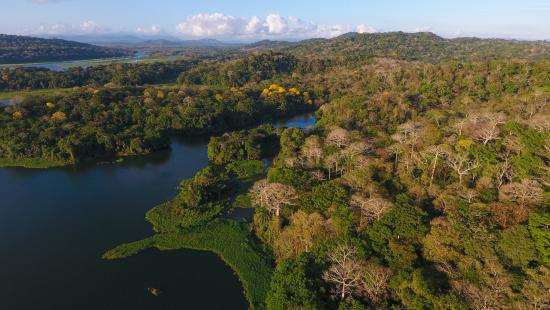
An aerial view of regenerating secondary tropical forest in the Barro Colorado Nature Monument, Panama. Credit: Christian Ziegler, Max Planck Institute of Animal Behavior.

A coati (Nasua narica) forages on palm fruits in a secondary forest, Panama. Credit: Christian Ziegler, Max Planck Institute of Animal Behavior.
The world’s wildlife populations have declined by almost 70% in the last 50 years as their habitats have been polluted and cleared by humans. Yet, animals play a crucial role in reforestation, a new study has found.
A coati (Nasua narica) forages on palm fruits in a secondary forest, Panama. Credit: Christian Ziegler, Max Planck Institute of Animal Behavior.
As nations meet this week in Montreal on efforts to address an unprecedented loss of biodiversity — more than a million species are threatened with extinction — a new study published in The Royal Society journal Philosophical Transactions points to the unique and vital role animals play in reforestation.

An aerial view of regenerating secondary tropical forest in the Barro Colorado Nature Monument, Panama. Credit: Christian Ziegler, Max Planck Institute of Animal Behavior.
An aerial view of regenerating secondary tropical forest in the Barro Colorado Nature Monument, Panama. Credit: Christian Ziegler, Max Planck Institute of Animal Behavior.
Efforts to restore forests have often focused on trees, but the study found that animals play a key role in the recovery of tree species by carrying a wide variety of seeds into previously deforested areas.
The study was conducted by an international team led by Sergio Estrada Villegas, a postdoctoral associate at the Yale School of the Environment, working with Professor of Tropical Forest Ecology Liza Comita. The project, which examined a series of regenerating forests in central Panama spanning 20 to 100 years post-abandonment, was completed by Estrada-Villegas during his time as a Cullman Fellow in the joint program between YSE and the New York Botanical Garden. The study was published in a special theme issue of the journal that focused on forest landscape restoration as part of the U.N. Decade of Ecosystem Restoration.
“When we talk about forest restoration, people typically think about going out and digging holes and planting seedlings,” Comita says. “That's actually not a very cost-effective or efficient way to restore natural forests. If you have a nearby preserved intact forest, plus you have your animal seed dispersers around, you can get natural regeneration, which is a less costly and labor-intensive approach.”
In these tropical environments, animals are paramount to a speedy recovery of forests."
The research team analyzed a unique, long-term data set from the forest in Barro Colorado Nature Monument in Panama, which is overseen by the Smithsonian Tropical Research Institute, to compare what proportion of tree species in forests were dispersed by animals or other methods, like wind or gravity, and how that changes over time as the forest ages. The team focused on the proportion of plants dispersed by four groups of animals: flightless mammals, large birds, small birds, and bats.
Because the area has been intensely studied by biologists at the Smithsonian for about a century, the research team was able to delve into data stemming back decades, including aerial photographs taken in the 1940s-1950s. The area also presents a unique view into forests where there is very little hunting or logging. The results offer the most detailed data of animal seed dispersal across the longest time frame of natural restoration, according to the study.
The role of flightless animals in seed dispersal across all forest ages, from 20 years to old growth, and the variety of animal species involved were among the most important findings of the study and point to the importance of natural regeneration of forests, Comita and Estrada-Villegas say. In tropical forests, more than 80% of tree species can be dispersed by animals.
The researchers say the findings can serve as a road map for natural regeneration of forests that preserve biodiversity and capture and store carbon at a time when the U.N. Decade of Restoration is highlighting the need for land conservation, and world leaders are working to mitigate climate change stemming from fossil fuel emissions. Forests soak up carbon dioxide from the atmosphere and store it in biomass and soils. Tropical forests, in particular, play an important role in regulating global climate and supporting high plant and animal diversity, the researchers note.
Estrada-Villegas, an ecologist who studies both bats and plants, says the study highlights how crucial animals are to healthy forests.
“In these tropical environments, animals are paramount to a speedy recovery of forests,” says Estrada-Villegas, who has recently joined the faculty of Universidad del Rosario in Bogotá, Colombia.
The study was co-authored by Daisy H. Dent, a tropical ecologist from the Max Planck Institute for Animal Behavior; Pablo Stevenson, of the Universidad de los Andes in Bogota, Columbia; Omar López, of the Smithsonian Tropical Research Institute in Balboa, Panama; and Saara J. DeWalt, chair of the Department of Biological Sciences at Clemson University.
